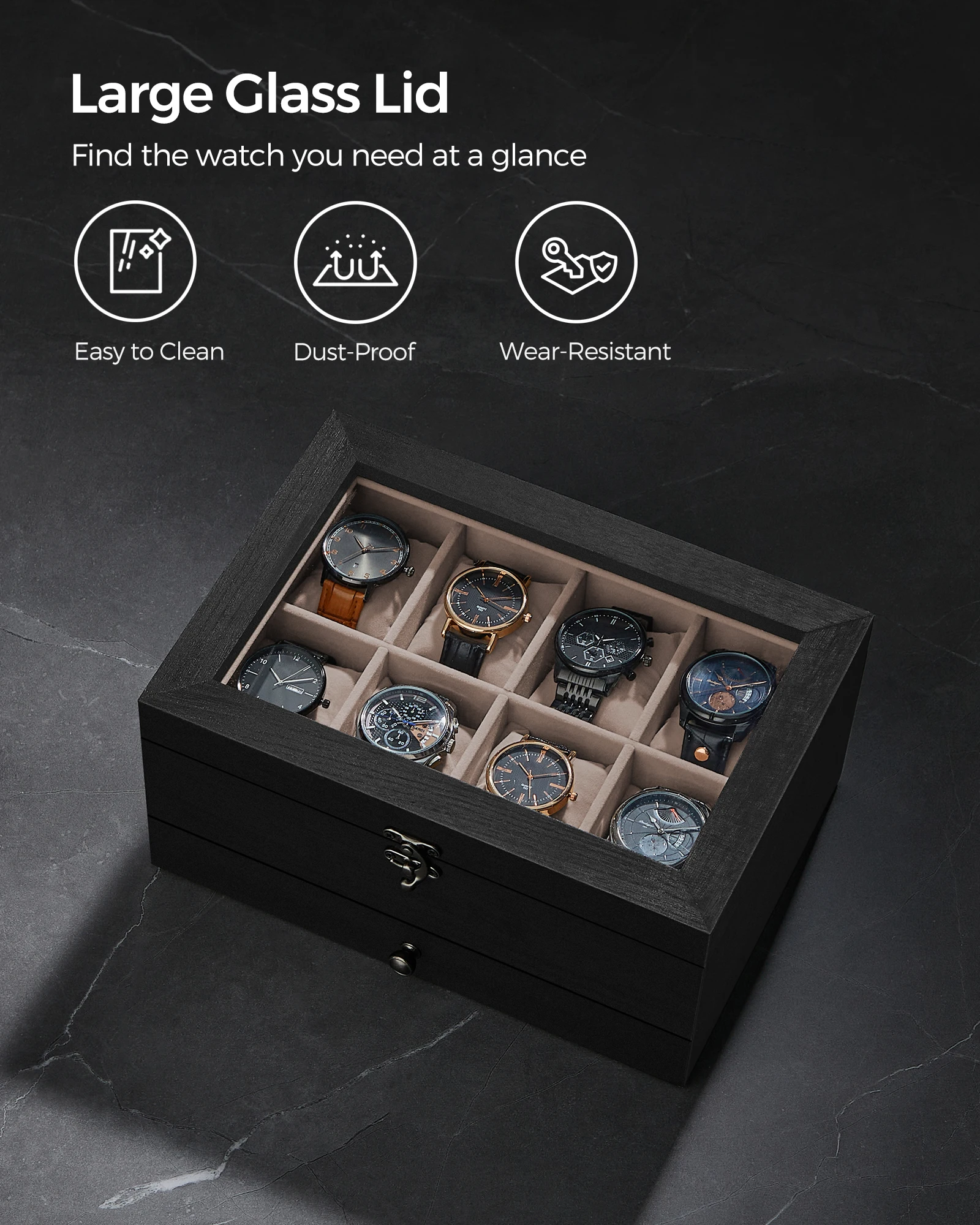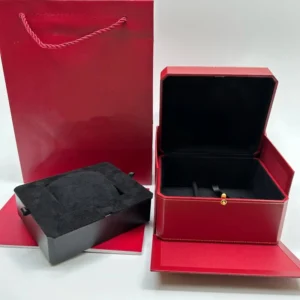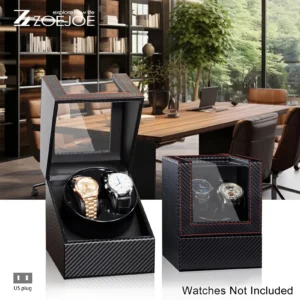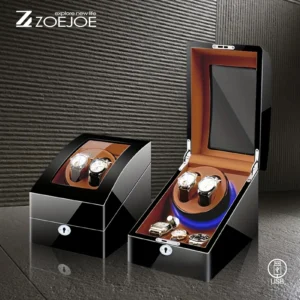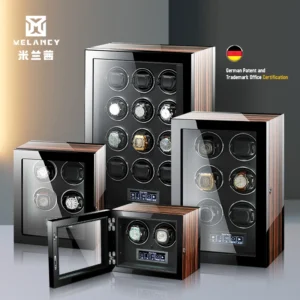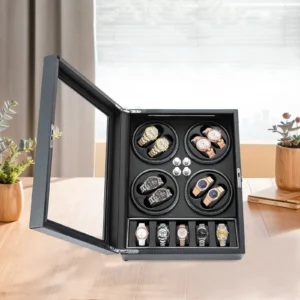1. Introduction: The Crucial Role of Watch Box Lining
When it comes to protecting your valuable timepieces, what’s inside your watch box matters just as much as the box itself. Watch box lining is the material that makes direct contact with your watches, serving as both a protective barrier and a presentation enhancer. The right lining does more than just look good—it prevents scratches, shields against dust, and minimizes the risk of damage during handling or storage.
Different lining materials offer varying levels of protection, aesthetic appeal, and longevity. Some excel at scratch prevention but may be difficult to maintain, while others offer superior durability but might not provide the same level of scratch protection. This balance between form and function is crucial when selecting the perfect watch storage solution.
In this comprehensive guide, we’ll examine:
- The essential properties that make certain materials better suited for watch storage
- Detailed comparisons of popular watch box linings from traditional options to modern alternatives
- How to match specific lining materials to different watch types and collection needs
- Maintenance tips to extend the life of your watch box lining
Proper watch collection storage planning requires careful consideration of these internal details that directly affect the condition of your timepieces over time.
2. Essential Criteria for Evaluating Watch Box Lining Materials
Before diving into specific materials, it’s important to understand what makes a good watch box lining. When evaluating different options, consider these key factors:
Protection capabilities: The primary function of any watch box lining is to protect your timepieces from scratches, dust, and impact damage. Some materials create a soft barrier that cradles watches gently, while others provide firmer support with less cushioning.
Durability and longevity: How well will the material hold up over years of use? Will it maintain its appearance and protective qualities, or will it deteriorate, pill, or compress with time?
Aesthetic qualities: Beyond protection, how does the lining complement your watches visually? Does it enhance the presentation and create an appropriate backdrop for your collection?
Maintenance requirements: Some materials can be easily spot-cleaned, while others may require professional attention or special cleaning products to maintain their appearance and function.
Breathability properties: Materials that allow some air circulation can help prevent moisture buildup, which is particularly important for mechanical watches.
Cost considerations: Premium materials often come with higher price tags but may offer superior protection or appearance.
Environmental and health factors: Some synthetic materials may release chemicals that could potentially affect watch components over time, while natural materials may have their own considerations.
When comparing types of watch storage, these factors help determine which solution will best preserve your collection while providing the aesthetic experience you desire.
3. Velvet Linings: Luxury and Protection Combined
Velvet is perhaps the most traditional watch box lining material, cherished for its soft pile and luxurious appearance. This woven fabric features short, dense cut threads that create a plush surface ideal for cradling delicate timepieces.
There are several velvet varieties commonly used in watch storage:
– Traditional velvet (usually cotton or silk-based)
– Microfiber velvet (synthetic alternative)
– Crushed velvet (with a multidirectional pile for added visual interest)
Pros:
– Exceptional softness that minimizes risk of scratching polished surfaces
– Dust-trapping ability keeps particles away from watch mechanisms
– Luxurious appearance enhances the presentation of fine timepieces
– Available in various colors to complement different watch box exteriors
– Provides good cushioning against minor impacts
Cons:
– Can be challenging to clean thoroughly when soiled
– May shed fibers with age, particularly in lower-quality implementations
– Can lose its plush texture over time with repeated use
– Generally not moisture-resistant
Velvet is particularly well-suited for dress watches and pieces with polished cases, where preventing micro-scratches is paramount. Many luxury watch boxes feature premium velvet linings specifically selected to enhance both protection and presentation of fine timepieces.
4. Suede Linings: Sophistication with Superior Grip
Suede offers a distinctive alternative to velvet with its unique texture and excellent grip properties. This material, derived from the underside of animal hide or manufactured synthetically, features a napped finish that prevents watches from sliding around within their compartments.
Pros:
– Superior grip helps keep watches securely positioned
– Sophisticated matte appearance appeals to many collectors
– Good scratch protection for most watch cases
– Available in both natural and synthetic versions
– Thin profile allows for more efficient space utilization
Cons:
– Prone to staining, particularly lighter colors
– Can be difficult to clean thoroughly
– May wear unevenly in high-contact areas
– Natural suede requires careful maintenance to preserve its appearance
Suede works particularly well for daily-wear watches and collections that include heavier timepieces that might shift during storage. The material’s grip quality makes it ideal for watch pillows where preventing movement is essential for both presentation and protection.
Natural suede tends to offer superior breathability compared to synthetic options, though modern synthetic suedes have improved significantly in this regard while offering better stain resistance.
5. Leather Linings: Classic Durability
Leather represents a time-tested option for watch box interiors, offering a perfect balance of protection and durability. Available in both genuine and synthetic versions, leather linings provide a classic aesthetic that ages gracefully.
Pros:
– Exceptional durability compared to fabric options
– Develops an attractive patina over time (genuine leather)
– Easy to wipe clean with appropriate leather care products
– Natural breathability helps prevent moisture issues (genuine leather)
– Maintains its protective qualities for many years with proper care
Cons:
– Generally less cushioning than plush fabric options
– Premium genuine leather adds significant cost
– May not be as scratch-resistant as velvet or suede
– Can be susceptible to drying and cracking if not maintained
Leather linings are particularly suitable for everyday watch storage where the boxes will be frequently opened and closed. The material stands up well to regular use while maintaining its appearance and protective qualities.
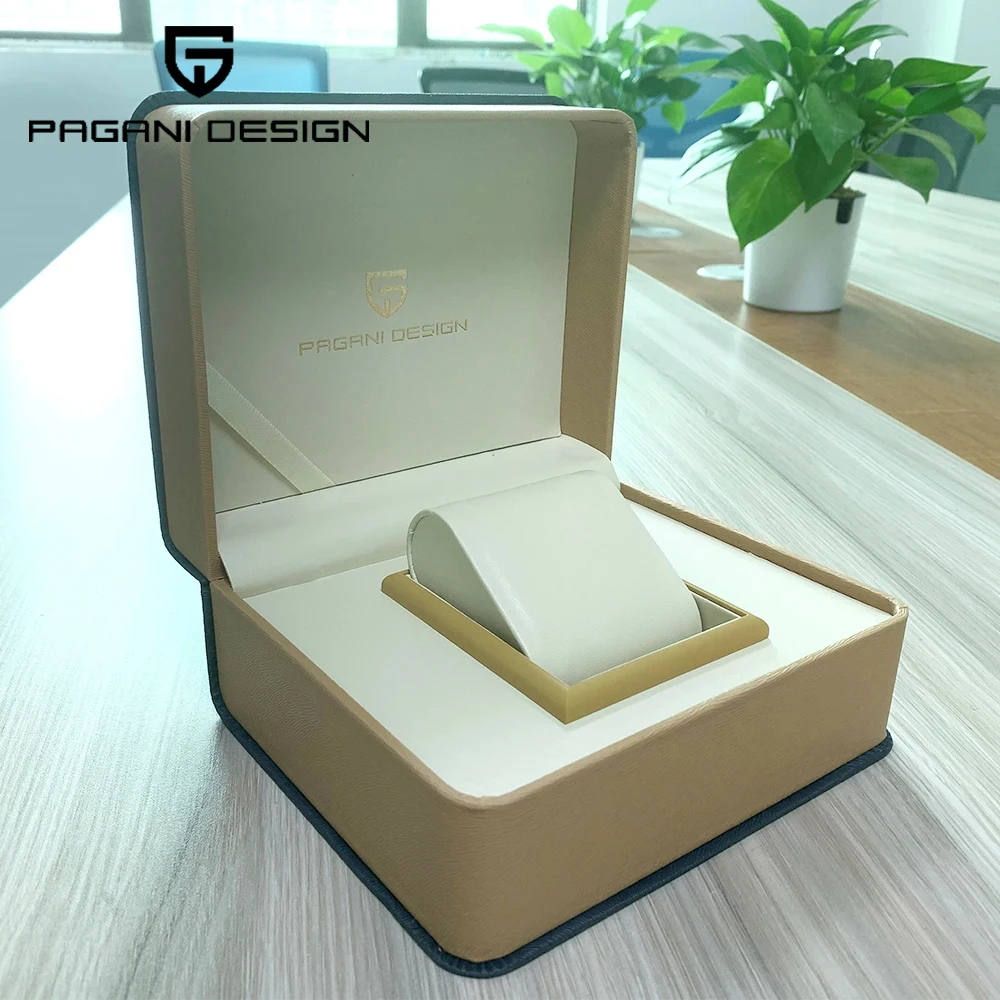
For collectors who appreciate traditional craftsmanship and materials that improve with age, leather watch boxes offer timeless appeal combined with practical benefits for long-term storage.
6. Silk and Satin Linings: Ultimate Gentleness
Silk and satin represent the height of luxury when it comes to watch box linings, offering unmatched softness and an elegant sheen. These smooth fabrics provide the gentlest contact with watch surfaces, making them ideal for highly polished or precious metal timepieces.
Pros:
– Exceptionally smooth surface minimizes risk of micro-scratches
– Elegant appearance enhances the presentation of luxury timepieces
– Naturally dust-resistant surface
– Visually striking with characteristic luster and light reflection
– Compatible with delicate watch finishes including high-polish metals
Cons:
– Less durable than most other lining options
– Prone to showing wear, pulling, or snagging
– Can be challenging and expensive to repair if damaged
– Often requires professional cleaning when soiled
– Premium pricing, especially for natural silk
These materials are most commonly found in high-end presentation boxes or specialized storage for exceptionally valuable watches. While less practical for everyday use, silk and satin create an unparalleled unboxing experience and are often preferred for watches that are displayed occasionally rather than accessed daily.
Watches with precious metal cases or highly polished surfaces benefit most from these ultra-gentle materials, as even minimal friction could potentially compromise their mirror finish.
7. Microfiber and Felt Linings: Practical Protection
For collectors seeking reliable protection at a more accessible price point, microfiber and felt linings offer practical solutions with their own unique advantages.
Microfiber:
– Synthetic material comprised of extremely fine fibers
– Excellent dust and debris capture
– Good scratch protection for most watch types
– Easy to clean with simple washing methods
– Highly durable with minimal pilling or wear over time
– Resists moisture better than many natural materials
Felt:
– Compressed wool or synthetic fibers forming a dense mat
– Provides firm but gentle support
– Available in various thicknesses and densities
– Cost-effective option for quality protection
– Good durability with proper care
– Naturally resistant to mold and mildew
Cons for both:
– Less luxurious appearance than premium materials
– Can generate static electricity that attracts dust (especially synthetics)
– May compress over time in high-pressure areas
– Limited breathability in some synthetic versions
These materials represent excellent choices for daily storage of most watches, offering a balance of protection, practicality, and value. Their resilience makes them particularly well-suited to collections that are frequently accessed.
When organizing your watch collection, these materials provide reliable protection while accommodating different storage configurations and watch types without requiring specialized maintenance.
8. Alcantara: Premium Synthetic Performance
Alcantara has emerged as a premium synthetic option for discerning collectors who want modern performance with a luxury feel. Originally developed for the automotive and fashion industries, this proprietary material combines the aesthetic appeal of suede with superior durability and maintenance characteristics.
Pros:
– Exceptional softness comparable to natural suede
– Superior durability with minimal wear patterns over time
– Resistant to staining and water damage
– Maintains appearance with basic cleaning
– Available in numerous color options
– Non-allergenic and environmentally friendlier than some alternatives
Cons:
– Significantly higher cost than standard synthetic options
– Requires specific cleaning products for best maintenance
– May be less breathable than natural materials
– Typically only found in premium watch storage solutions
Alcantara represents an excellent choice for collectors seeking a modern alternative to traditional materials without sacrificing luxury appeal. Its combination of softness, protection, and durability makes it particularly well-suited for watch rolls and travel cases where material performance under varied conditions is essential.
The material’s resistance to wear makes it an excellent long-term investment for collectors who access their watches frequently, as it maintains its protective qualities and appearance far longer than many alternatives.
9. Specialized and Alternative Lining Materials
Beyond the common options, several specialized materials serve particular needs within the watch collecting community:
Nylon:
– Extremely durable and abrasion-resistant
– Often used in travel cases and watch rolls
– Excellent water resistance
– Lightweight and flexible
– Less scratch protection than plush alternatives
Cotton:
– Natural breathability
– Hypoallergenic qualities
– Machine washable in many implementations
– Good for vintage watches that benefit from air circulation
– Less cushioning than plush synthetic options
Anti-static Materials:
– Specifically designed to prevent dust attraction
– Beneficial for watches with exposed movements
– Minimizes risk of static discharge near sensitive components
– Often incorporated into high-tech storage solutions
Antimicrobial Fabrics:
– Prevent growth of mold or mildew
– Particularly valuable in humid environments
– Often combined with moisture-wicking properties
– Help protect leather straps from deterioration
These specialized materials typically address specific storage concerns rather than serving as universal solutions. They’re most commonly found in travel storage, tool watch protection, or storage systems designed for particular environmental challenges.

10. Comparative Analysis: Matching Materials to Your Collection
To help determine which lining material might best suit your specific needs, consider this comprehensive comparison across key factors:
| Material | Protection | Durability | Aesthetics | Maintenance | Cost | Special Properties |
|---|---|---|---|---|---|---|
| Velvet | ★★★★★ | ★★★☆☆ | ★★★★★ | ★★☆☆☆ | ★★★☆☆ | Superior cushioning |
| Suede | ★★★★☆ | ★★★☆☆ | ★★★★☆ | ★★☆☆☆ | ★★★☆☆ | Excellent grip |
| Leather | ★★★☆☆ | ★★★★★ | ★★★★☆ | ★★★★☆ | ★★★★☆ | Develops patina |
| Silk/Satin | ★★★★★ | ★★☆☆☆ | ★★★★★ | ★★☆☆☆ | ★★★★★ | Gentlest surface |
| Microfiber | ★★★★☆ | ★★★★☆ | ★★★☆☆ | ★★★★☆ | ★★☆☆☆ | Easy cleaning |
| Felt | ★★★☆☆ | ★★★☆☆ | ★★☆☆☆ | ★★★☆☆ | ★★☆☆☆ | Good value |
| Alcantara | ★★★★☆ | ★★★★★ | ★★★★☆ | ★★★★☆ | ★★★★☆ | Modern luxury |
| Nylon | ★★☆☆☆ | ★★★★★ | ★★☆☆☆ | ★★★★★ | ★★☆☆☆ | Water resistant |
When selecting materials, consider which factors matter most for your specific collection. A collector with highly polished luxury pieces might prioritize protection above all else, while someone with robust tool watches might value durability and ease of maintenance.
Your storage habits should also influence your choice—daily access suggests durable materials, while occasional viewing might allow for more delicate but visually striking options. Understanding watch storage ideas for collectors can help you match materials not just to your watches, but to your collecting lifestyle.
11. Material Recommendations for Different Watch Types
Different watches benefit from specific lining materials based on their characteristics:
For Luxury and Collectible Timepieces:
– Velvet provides superior scratch protection
– Silk offers the gentlest contact for highly polished surfaces
– Alcantara combines luxury with practical durability
– Consider natural materials to avoid potential chemical interactions
For Everyday Watches:
– Microfiber delivers reliable protection with easy maintenance
– Leather offers durability with a classic aesthetic
– Synthetic suede provides grip with good stain resistance
– Focus on materials that can be easily cleaned
For Vintage or Delicate Watches:
– Natural silk minimizes risk to fragile components
– Cotton allows beneficial air circulation
– Avoid synthetics that might off-gas chemicals
– Consider breathable materials that prevent moisture buildup
For Sports/Tool Watches:
– Nylon withstands the rigors of more robust timepieces
– Synthetic microfiber resists moisture and dries quickly
– Materials with antimicrobial properties protect rubber straps
– Prioritize durability over luxury feel
For Travel Storage:
– Water-resistant materials protect against environmental changes
– Densely woven synthetics prevent dust infiltration
– Shock-absorbing options provide extra protection
– Avoid materials that might compress or damage under pressure
The balance between protection and presentation varies significantly based on watch type. Handcrafted watch box materials can be selected to complement specific watches, enhancing both their safety and display appeal.
12. Warning Signs: Materials to Avoid for Watch Storage
Not all materials are suitable for watch storage. Be wary of these red flags when evaluating watch box linings:
Chemical off-gassing: Low-quality synthetic materials may release volatile organic compounds (VOCs) that can potentially damage watch components or discolor straps over time. If you detect strong chemical odors, consider this a warning sign.
Rough or abrasive textures: Materials with inconsistent surfaces, rough spots, or hard inclusions can scratch watch cases. Always test by gently running your wrist across the surface—you should feel only smooth, consistent texture.
Non-colorfast dyes: Poorly dyed materials can transfer color to watch straps, particularly light-colored leather or rubber. Test by rubbing the lining with a damp white cloth—no color should transfer.
Inadequate padding: Extremely thin linings that provide minimal cushioning increase the risk of damage from minor impacts. Quality lining should have appropriate thickness for its material type.
Signs of poor construction: Loose threads, uneven application, bubbling, or separation from the base indicate poor quality that will likely deteriorate quickly with use.
Stiff plastic or vinyl surfaces: These materials can stick to watch cases and straps in warm conditions, potentially causing damage when watches are removed.
To evaluate unknown materials, consider conducting a simple test: place a less valuable watch in contact with the lining for a few days, then examine it for any marks, residue, or other signs of interaction.
13. Maintenance Tips for Watch Box Linings
Proper maintenance extends the life and protective qualities of your watch box lining:
For Velvet and Suede:
– Regularly use a soft brush to remove dust and prevent matting
– Address spills immediately with blotting (never rubbing)
– Use compressed air to clean crevices without contact
– Keep away from direct sunlight to prevent fading
– Consider professional cleaning for significant soiling
For Leather:
– Wipe with a slightly damp cloth periodically
– Use leather conditioner sparingly once yearly
– Allow to air out regularly to prevent moisture buildup
– Avoid direct sunlight to prevent drying and cracking
– Keep away from extreme temperature fluctuations
For Silk and Satin:
– Spot clean gently with specialized silk cleaners
– Avoid water which can cause water spots
– Prevent contact with sharp objects that might snag
– Store away from direct sunlight to prevent deterioration
– Consider professional cleaning rather than DIY attempts
For Synthetic Materials:
– Follow manufacturer cleaning guidelines when available
– Test cleaning products on an inconspicuous area first
– Use appropriate lint rollers for surface dust and debris
– Allow complete drying before returning watches if moisture was used
Regardless of material, all watch box linings benefit from periodic airing out to prevent moisture accumulation. Understanding long-term watch storage protection techniques helps ensure both your watches and their storage solutions remain in excellent condition.
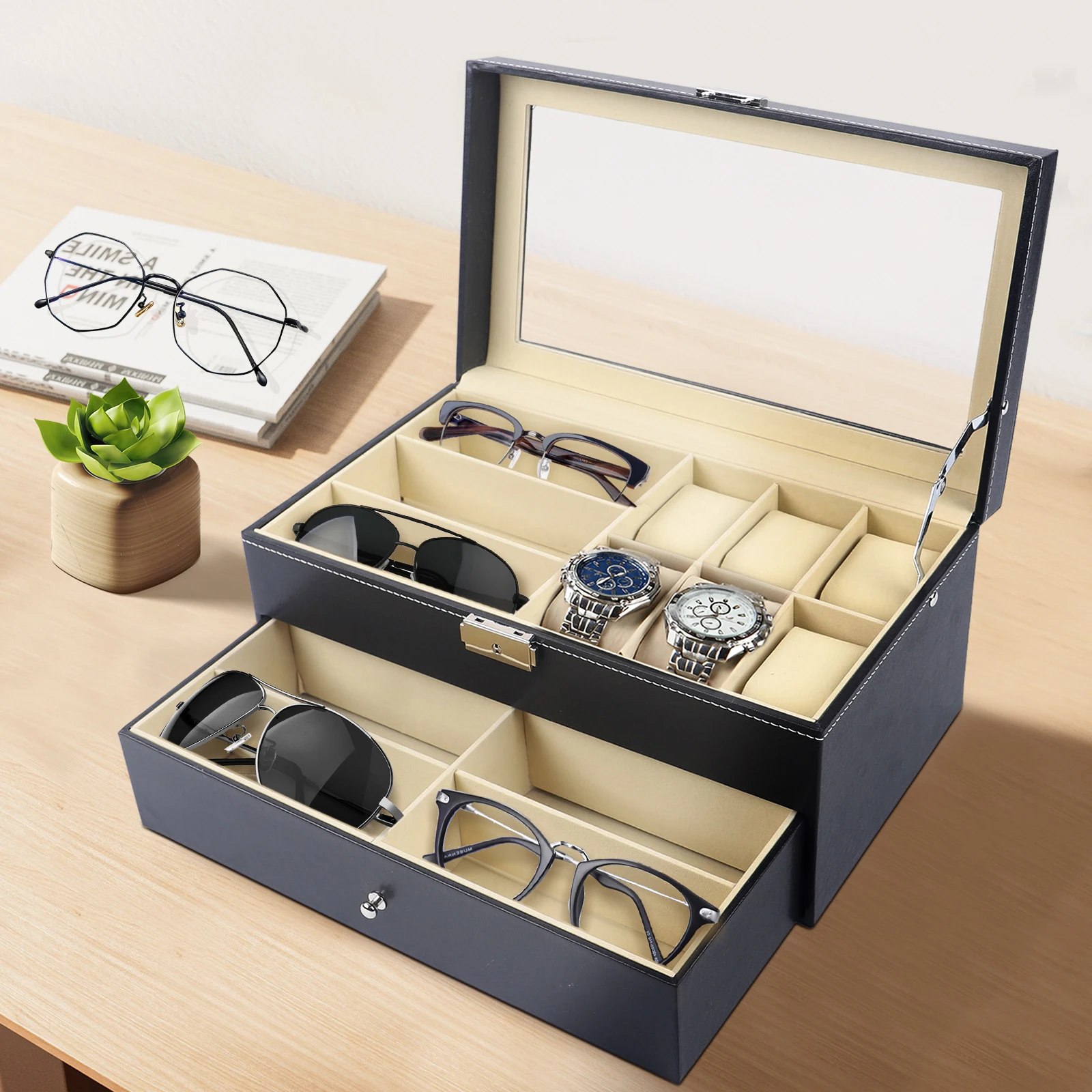
Luxury Watch Boxes, Men's Watch Boxes, Single Watch Box
Price range: $903.35 through $980.97 Select options This product has multiple variants. The options may be chosen on the product pageLuxury Watch Boxes, Luxury Watch Travel Case
Price range: $200.33 through $224.57 Select options This product has multiple variants. The options may be chosen on the product pageAutomatic Watch Winder, Double Watch Winder, Leather Watch Boxes
$147.60 Select options This product has multiple variants. The options may be chosen on the product pageAutomatic Watch Winder, Luxury Watch Boxes, Watch Pillows
$294.54 Select options This product has multiple variants. The options may be chosen on the product pageAutomatic Watch Winder, Luxury Watch Winder, Wooden Watch Boxes
Price range: $1,029.25 through $3,964.40 Select options This product has multiple variants. The options may be chosen on the product pageAutomatic Watch Winder, Watch Display Case, Watch Pillows
$718.45 Select options This product has multiple variants. The options may be chosen on the product page
14. Frequently Asked Questions About Watch Box Linings
Can lining materials damage watches over time?
Low-quality or inappropriate lining materials can potentially damage watches. Materials that off-gas chemicals, transfer dye, or have rough surfaces pose the greatest risk. Quality linings from reputable manufacturers are specifically selected to be safe for long-term watch contact.
Is it possible to replace or upgrade the lining in an existing box?
Yes, many watch boxes can be relined, though the process requires care. Professional services offer relining, or DIY options are available for those with crafting skills. Adhesive-backed materials designed for jewelry boxes work well for many applications.
Are there hypoallergenic options for sensitive individuals?
Yes, many synthetic materials like microfiber and certain treated natural fabrics are hypoallergenic. Alcantara is an excellent premium option for those with sensitivity concerns.
How often should lining be cleaned?
For boxes in regular use, a light cleaning (brushing or compressed air) monthly and deeper cleaning quarterly is generally sufficient. Boxes used less frequently may require only seasonal maintenance.
Do watch winders require different lining considerations?
Watch winders benefit from non-shedding materials that won’t interfere with mechanical components. Microfiber, smooth synthetics, or leather are typically preferred over plush options like velvet that might shed fibers.
15. Making Your Final Decision: Balancing Form and Function
Selecting the ideal watch box lining ultimately comes down to balancing three key considerations:
- Protection level required by your specific watches
- Visual presentation that complements your collection
- Practical considerations like maintenance and durability
For most collectors, a hybrid approach often works best—perhaps velvet-lined compartments for dress watches, leather or Alcantara for daily wear pieces, and specialized materials for unique timepieces like dive watches or vintage collections.
Remember that quality matters significantly with all materials. A well-crafted microfiber lining will outperform poor-quality silk or velvet in both protection and longevity. When possible, physically inspect the lining before purchase or rely on reputable retailers with detailed product information and return policies.
Consider your long-term collecting journey as well. Will your collection grow or change focus? Versatile materials like premium microfiber or Alcantara might accommodate evolving needs better than highly specialized options.
At Daily Accents, we understand that proper storage is an extension of the care and appreciation you have for your timepieces. The right wooden watch boxes with appropriate lining not only protect your investment but enhance the joy of collecting by creating a worthy home for pieces that often carry both financial and emotional value.

